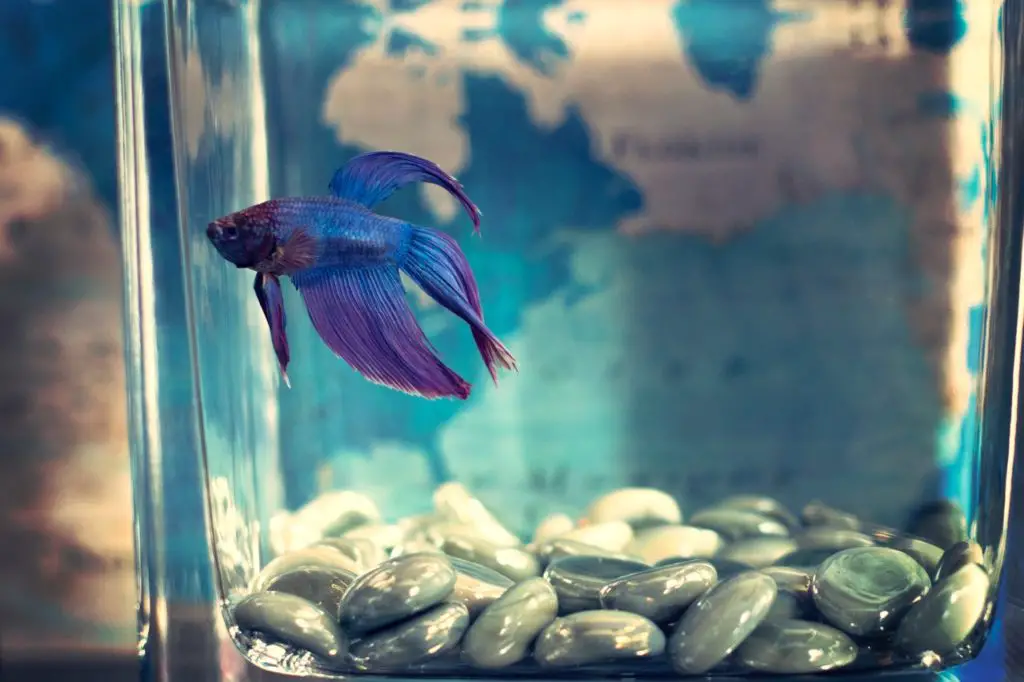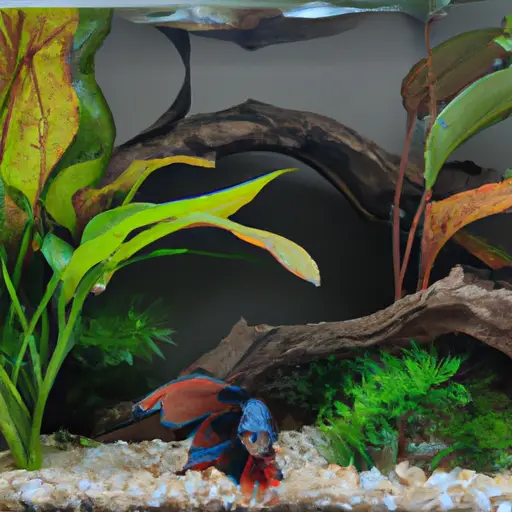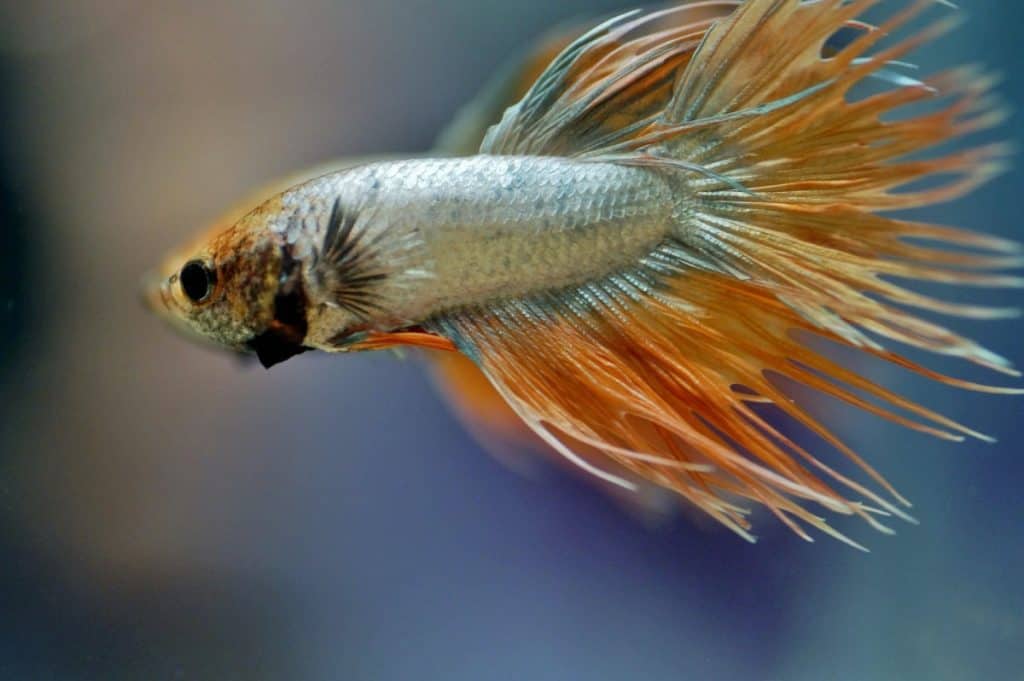Betta fish, also known as Siamese fighting fish, are popular for their vibrant colors and feisty personalities. To keep your betta fish happy and healthy, providing them with a properly-sized tank and a suitable habitat is essential.
The bigger the aquarium size, the better, but I think for a betta-only tank, you can get away with a 5-gallon tank as a minimum.
In this blog article, we will explore the benefits of keeping betta fish in a 5-gallon tank and provide tips and tricks for setting up and maintaining a healthy environment for your feisty friend. By following these guidelines, you can ensure that your betta fish will thrive in their new home.
Betta Fish Tank Setup
Choosing the right tank size and shape for your betta fish is important in ensuring their health and happiness. A minimum tank size of 5 gallons is recommended for betta fish, as it provides enough space to swim and explore without being too large for them to maintain. In terms of shape, betta fish prefer wide and shallow tanks, as they tend to swim near the surface of the water.

Steps for 5-Gallon Betta Fish Tank Setup
Setting up a 5-gallon betta fish tank is a relatively simple process. Still, it is important to take the time to do it properly to provide your fish with a healthy and comfortable environment. Here are the steps to follow when setting up a 5-gallon betta fish tank:
1. Choose the right tank size and shape. A 5-gallon tank is perfect for a betta fish, as it provides enough space to swim and explore without being too large to maintain. Choosing a tank with a wide and shallow shape is also essential, as betta fish prefer to swim near the water’s surface.
2. Set up the tank in the right location. Betta fish are tropical fish and need a warm, stable environment. Choose a spot for your tank that is out of direct sunlight and away from drafty areas. Avoid placing the tank near windows or other sources of extreme temperature changes.
3. Clean and rinse the tank thoroughly. Before adding water and fish to your tank, it is essential to clean and rinse it thoroughly to remove any dust or debris. Use a mild aquarium-safe cleaner and rinse the tank multiple times with clean water to ensure it is free of any chemicals or contaminants.
4. Add a suitable substrate. The substrate is the material that lines the bottom of your tank and provides a natural-looking habitat for your fish. Gravel and sand are popular choices for betta fish tanks, but avoiding using a small or sharp-edged substrate that your fish could swallow is important.
5. Install the necessary equipment. Betta fish need a heater to maintain a stable water temperature and a filter to keep the water clean and oxygenated. Choose appropriate equipment for your tank’s size and follow the manufacturer’s instructions for installation and use.
6. Fill the tank with water. Once your tank is set up and equipped with the necessary equipment, you can begin filling it with water. Use dechlorinated water to fill the tank, and avoid using tap water, as it may contain chemicals that can harm your fish. Slowly fill the tank and prevent splashing, which can cause oxygen levels to drop.
7. This step I always find the most challenging; letting your tank cycle. A cycled tank is an aquarium considered healthy and stable and has established a beneficial bacterial colony to break down fish waste and other organic matter. This can take about 3 to 4 weeks.
8. Acclimate your fish. Before adding your fish to the tank, it is essential to acclimate them to the new environment. Slowly introduce them to the tank water by floating their container in the tank for about 15 minutes. This will allow the water temperature and pH levels to adjust to the fish.
By following these steps, you can set up a healthy and comfortable 5-gallon betta fish tank that will provide your fish with a happy and healthy home. It is important to monitor and maintain the tank regularly, including performing regular water changes and monitoring water quality and temperature. With proper care, your betta fish will thrive in their new tank.

Essential Equipment for A 5-Gallon Betta Fish Tank
The necessary equipment for a 5-gallon betta fish tank includes:
- Heater: Betta fish are tropical and need a stable water temperature between 76 and 80 degrees Fahrenheit. A heater is essential for maintaining this temperature in a 5-gallon tank.
- Filter: A filter is important for keeping the water in a betta fish tank clean and oxygenated. A small, low-flow filter is suitable for a 5-gallon tank.
- Thermometer: If To you want to ensure that the water temperature in your betta fish tank remains within the appropriate range, it is essential to use a thermometer to monitor it. An aquarium thermometer is a reliable and accurate way to measure water temperature.
- Water conditioner: Tap water contains chemicals like chlorine and chloramine that can harm fish. A water conditioner is necessary for removing these chemicals and making the water safe for your betta fish.
- Substrate: The substrate is the material that lines the bottom of your tank and provides a natural-looking habitat for your fish. Gravel and sand are popular choices for betta fish tanks.
- Aquarium light: Betta fish need a light source in their tank to maintain a natural light-dark cycle. An aquarium light can provide this and enhance your tank’s appearance.
- Gravel vacuum: A gravel vacuum is a valuable tool for cleaning the substrate in your tank and removing excess debris and waste. It is important to regularly clean the substrate in a betta fish tank to maintain good water quality.
- Fish net: A fish net is essential for safely transferring your betta fish from their container to the tank and removing them from the tank for cleaning or medical treatment. Choose a fish net with a fine mesh to prevent damaging your fish’s delicate fins.
Water Quality for A 5-Gallon Betta Fish Tank
Maintaining good water quality in a betta fish tank is essential for the health and happiness of your fish. Water quality refers to the water’s chemical, physical, and biological characteristics, and it is important to keep these factors within the appropriate range for betta fish.
One of the critical aspects of water quality is pH, a measure of the acidity or alkalinity of the water. Betta fish prefer a slightly acidic pH between 6.5 and 7.5. Water pH can be tested using a simple kit purchased from a pet store, and if the pH is outside the appropriate range, it can be adjusted using a pH-adjusting product.
Another important aspect of water quality is temperature. Bettas are tropical fish and need a stable water temperature between 76 and 80 degrees Fahrenheit. A heater is essential for maintaining this temperature in a betta fish tank. A thermometer can monitor the water temperature and ensure it remains within the appropriate range.
It is necessary to regularly clean and maintain your betta fish tank to prevent common water quality issues like ammonia and nitrite buildup. This includes regular water changes and cleaning the substrate to remove excess debris and waste. A filter can also help to keep the water clean and oxygenated, and it is important to choose a filter that is appropriate for the size of your tank.
Regularly monitoring and maintaining your betta fish tank can prevent common water quality issues and keep your fish healthy and happy.

The Importance of Feeding Your Betta Properly
Proper feeding and nutrition are essential for the health and happiness of your betta fish. Betta fish have specific dietary needs, and providing them with the right food and amount is crucial for their overall health.
Regarding dietary needs, betta fish are carnivores and need a diet high in protein. You can feed them various commercial fish foods, including pellets, flakes, and freeze-dried or frozen foods. Choosing a high-quality food formulated explicitly for betta fish is vital and provides the necessary nutrients.
Regarding the right amount of food, betta fish should be fed once or twice a day and only as much as they can in a few minutes. Overfeeding can lead to a buildup of excess waste in the tank, which
can cause water quality issues and harm your fish. Avoid feeding your betta fish more than they can eat in one sitting, and remove any uneaten food from the tank after a few minutes.
Maintaining a healthy diet for your betta fish is essential for their overall health and well-being. In addition to providing them with high-quality fish food, offering them a varied diet, including the occasional treats like live or frozen foods, is also a good idea.
By providing your betta fish with a balanced and nutritious diet, you can help them to thrive and stay healthy.
How to Keep Your Betta Happy and Healthy
Here are some tips for keeping your betta fish happy and healthy:
1. Understand the natural behavior of betta fish. Betta fish are solitary and territorial, so they should be kept in tanks or containers. They also require plenty of hiding spots and plants in their environment.
2. Look for signs of a happy and healthy betta fish. This may include bright, vibrant colors, active movement, and a good appetite. A healthy betta fish will also have clean water in their tank.
3. Monitor for common health issues in betta fish. Some common health issues in betta fish include fin rot, infections, and constipation. To prevent these issues, keeping the tank clean, providing a balanced diet, and maintaining proper water quality and temperature are essential.
4. Take preventative measures to keep your betta fish healthy. This may include regular water changes, cleaning the tank and its accessories, and providing a high-quality diet. It’s also essential to monitor your betta fish regularly for any signs of illness or stress.
Overall, by understanding the natural behavior of betta fish and taking steps to prevent common health issues, you can help keep your betta fish happy and healthy.
Regular maintenance and monitoring are vital to ensuring the health and well-being of your betta fish.
Conclusion
Here are some key points to keep in mind when maintaining a healthy 5-gallon betta fish tank:
1. Keep the tank clean and well-maintained. This means performing regular water changes, cleaning the tank and its accessories, and monitoring the water quality to ensure it is within the acceptable range for betta fish.
2. Provide your betta fish with a high-quality, balanced diet. This should include a variety of foods such as pellets, flakes, and live or frozen foods.
3. Ensure the tank is adequately heated and aerated. Betta fish require a water temperature of around 76-82 degrees Fahrenheit and adequate oxygen levels.
4. Provide your betta fish with plenty of hiding spots and plants. Betta fish are territorial and need places to hide and establish their own space. Live plants can also help to oxygenate the water and provide natural habitats for beneficial bacteria.
5. Monitor your betta fish regularly for signs of illness or stress. This may include changes in behavior, appetite, or appearance. If you notice any changes, it’s essential to address them promptly to prevent further health problems.
Regular maintenance and monitoring are the keys to a healthy 5-gallon betta fish tank. By taking the time to care for your betta fish and their environment properly, you can help ensure their health and happiness.
